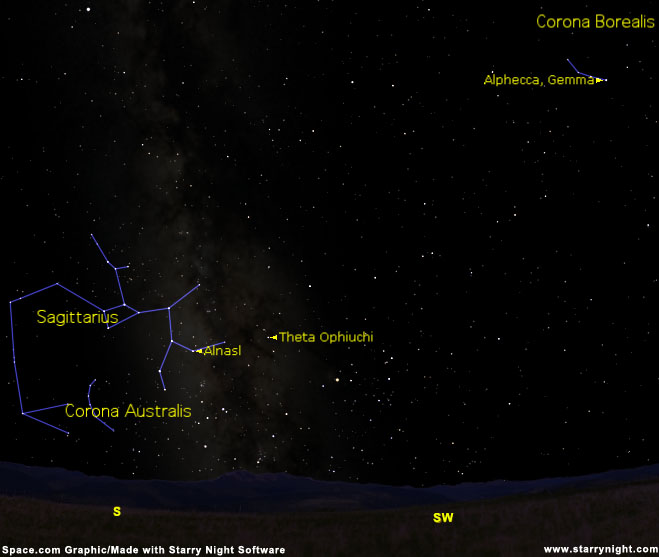
On these mid-summer evenings after the sun has set, look low toward the southeast part of the sky for the classical Archer, Sagittarius.
Traditionally it's supposed to represent a centaur (half man, half horse), one of two such creatures in the sky. (The other is Centaurus, a large, complex star pattern best viewed during the spring from far-southern localities.) Although often depicted in allegorical star atlases as a centaur, long ago he was not a centaur at all but simply a standing Archer (looking with some apprehension toward the Scorpion immediately to his west).
The sky map of Sagittarius available here shows the constellation's location in the night sky.
Here's a weird question: If a centaur ever got sick, where might he go — to a physician or a veterinarian?
Teapot or Dipper?
Although tracing out an Archer-Centaur among Sagittarius’ stars does require some imagination, visualizing it as a Teapot is quite easy. As star pictures go it's one of the best. About 40 years ago, astronomy author George Lovi (1939-1993) pointed out that we could augment our tea service with a teaspoon and lemon as well.
The teaspoon comprises stars in northern Sagittarius, while the lemon is an alternate rendition of the faint constellation Corona Australis, the Southern Crown, which lies directly beneath the Teapot.
Get the Space.com Newsletter
Breaking space news, the latest updates on rocket launches, skywatching events and more!
Some star guides also refer to the "Milk Dipper" of Sagittarius. Indeed, with not much difficulty we can trace out an upturned dipper with a bowl and bent handle — sort of a smaller version of the famous Big Dipper. And this particular Dipper indeed seems to be dipping into a rich source of milk: the Milky Way!
Milky Way week
And with the moon near new phase this week, now is also the best time to enjoy viewing the summer Milky Way. Never visible from large cities with their lights, smoke and haze, it can still be readily viewed from distant suburbs and rural locations. [Telescopes for Beginners]
Before the invention of the telescope, the true nature of the Milky Way galaxy ("Gala" is Greek for milk) was a mystery. Binoculars and telescopes reveal that the galaxy consists of dense clouds of individual stars. Several clouds of stars surrounded by a few dark regions for contrast can be seen with binoculars in the area of the Milky Way about halfway between Altair and Sagittarius.
About two-fifths of the way up from the star Al Nasl northwest to Theta Ophiuchi lies the direction of the center of our Milky Way, appearing as a veritable cloud of stars. Here lies the "hub," or central condensation, of our own galaxy, an area of density and complexity. Even to the unaided eye, the view is one of excitement and beauty.
Sweep up with binoculars from the Scorpion's tail, through the Summer Triangle, and down to Cassiopeia and Perseus. You’ll find concentrations of stars, clusters, large apparent gaps such as the Great Rift in Cygnus, and more stars than you thought existed.
Seen from a truly dark sky, the region of the Sagittarius Milky Way almost seems to resemble billowing puffs of smoke; perhaps a better name would be the "Smoky Way?"
Our home
The Sagittarius Star Cloud, about 30,000 light years distant, seems to be the nucleus, with the sun and all the outer stars of the galaxy turning at the rate of 155 miles (250 kilometers) per second. It requires about 200 million of our Earthly years to make one complete revolution, called a "cosmic year." The star cloud's outer edge is about 20,000 light years in the opposite direction.
This is "Our Galaxy," to be spoken with pride, just as we would say, "My house." Via Lactea is the Latin for the system's appearance in the sky. For the same idea the Greeks used gala and kyklos, meaning milk and circle, hence our word galaxy. The English poet John Milton (1608-1674) once wrote of the Milky Way as a "broad and ample road whose dust is gold and pavement stars."
When we began to realize that there were other such vast aggregations of stars, we called them "island universes," but this was an obvious misnomer; since the word universe means everything there is, it can hardly have a plural. So we've settled on galaxies, which is a compromise as a new meaning for an old word.
Joe Rao serves as an instructor and guest lecturer at New York's Hayden Planetarium. He writes about astronomy for The New York Times and other publications, and he is also an on-camera meteorologist for News 12 Westchester, New York.
Join our Space Forums to keep talking space on the latest missions, night sky and more! And if you have a news tip, correction or comment, let us know at: community@space.com.

Joe Rao is Space.com's skywatching columnist, as well as a veteran meteorologist and eclipse chaser who also serves as an instructor and guest lecturer at New York's Hayden Planetarium. He writes about astronomy for Natural History magazine, Sky & Telescope and other publications. Joe is an 8-time Emmy-nominated meteorologist who served the Putnam Valley region of New York for over 21 years. You can find him on Twitter and YouTube tracking lunar and solar eclipses, meteor showers and more. To find out Joe's latest project, visit him on Twitter.









